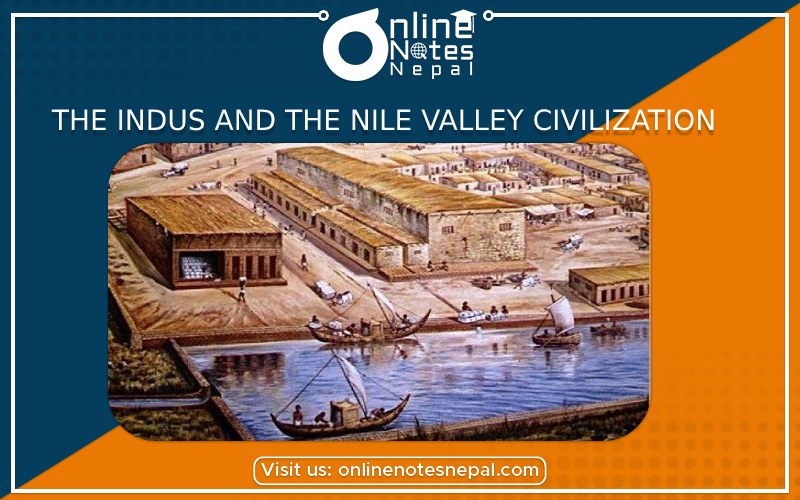Published by: Mandira
Published date: 27 Jan 2022

The development made by human beings by establishing residence, housing, road, agriculture, art, education, dress, etc. to make their life happy, healthy and prosperous is known as civilization. Different civilizations have been developed by the human beings and some civilizations are already developed and some are being developed. Some are still existing and some have ended up. For example, Ancient Greek, Babylonia, Persia etc have been ended up but the Chinese, Roman and Aryan civilization are still in existence.
Most of the civilization exist on the bank of the river. Such a similarity exists with all civilization because of the availability of the fertile soil, water for drinking, irrigation, grass for the animals, etc. Like other civilizations Indus Valley civilizations also developed on the bank of the river. The two important cities of this civilization are Harappa on the bank of the Ravi river and Mohenjo-Daro on the bank of the Indus river. They are in Pakistan at present. This civilization is supposed to have flourished between 2300 - 1750 BC. The excavations of these places started in 1920 AD.
The Cities
On the basis of excavations, it was found that Mohenjo-DaroandHarappa were well-planned cities. Harappa was surrounded by 12 meters wide brick walls. Similarly, Mohenjo-Daro was surrounded by 11 meters wide brick walls. There were many houses made of baked bricks. Some houses were small and some were multi-storeyed. Every house had a well and a bathroom. A large pond has been discovered in Mohenjo-Daro where general people could bath. There was also crematorium as well as a great granary in Harappa.
The Society
There were no big places found while observation and historians guess that no king had ruled over there and the administration was conducted by the people. The images of a bull and a man surrounded by animals were found in some places. Besides this, the images of some goddesses were found in different places. It indicates that there were a matriarchal society and the tradition of worshipping goddesses. The main sources of amusement were animal fighting and playing dice.
Economic Condition of Indus Valley:
The major occupation of the people was farming. They grew wheat, barley, and pea. Animals like goats, pigs and bulls were reared. Wheat was the staple food. They also ate meat, eggs, fish and watermelon too. They used to cultivate cotton and they wore the clothes made from cotton. Both male and female wore ornaments. They used coppers, brass and silver pots.
About 5,000 years ago a civilization developed in a country named Egypt, a northern part of Africa. That civilization is called the Nile Valley civilization or the Egyptiancivilization. Like the Indus Valley civilization, this civilization also developed on the bank of the Nile river. It is the oldest civilization of the world.
The Nile Valley civilization is also called the civilization of pyramid. A pyramid is a structure having a rectangular base and four triangular faces culminating in a single apex. It was used a tomb. There are still 30 pyramids in the Egypt. The Giza pyramid is the largest pyramid which was built about 4500 years ago which have the height of 143 metres covering 13 acres of land. It was built by the Khufu, the king of Egypt. In ancient Egypta king was called 'Pharaoh'. A hundred thousand workers worked for 20 years to built this pyramid. The Egyptians made many temples. The Karnak temple strikes the attention of all. It has 130 pillars inside the temple. They are 60 metres deep made by cutting the rock. On its entrance, there are four big statues of 20 metres high. This temple is called the Sun temple.
The Egyptians made progress in several fields. They developed writing and there were engineers and doctors in Egypt. It was the engineers of Egypt who made the pyramids and temples. They surveyed the land and made dams and canals. The Egyptian doctors were familiar with the anatomy and of the human body. They used herbs and roots for treatments. The system of calendar was also started from Egypt. The Egyptians studied the stars and prepared the calendar.
Social Life
The Egyptian society was divided into three classes. The upper class which consisted of King, the royal family, aristocrats, priests and soldiers. The middle class consisted of traders and craftsmen. Those who were defeated and arrested in war were made slaves. The slaves were known as lower class.
The Egyptians were pantheists. They believed in many gods who controlled nature. They worshipped sun, river, wind, the moon, etc. They believed in the reincarnation (rebirth) and immortality of soul. So, they kept the dead body safe by constructing pyramids. The huge pyramids is for royal family, kings and for rich peoples whereas small pyramid is for poor peoples.
Economic Life
The main occupation of the people of Egypt was Agriculture. The Nile river brought flood-washed soil which was very fertile and helped to grow varietis of crops. So, Egypt is called the 'Gift of the Nile'. The people of Egypt irrigate wheat, barley, pea, potato, etc. They also did the jobs of smiths, carpentry, metal-craft, weaving, clay works, etc. They exported mainly wheat, linen and golden ornaments. They imported ostrich feathers, metal weapons, wood and silver. Trade is well grown in Egypt.